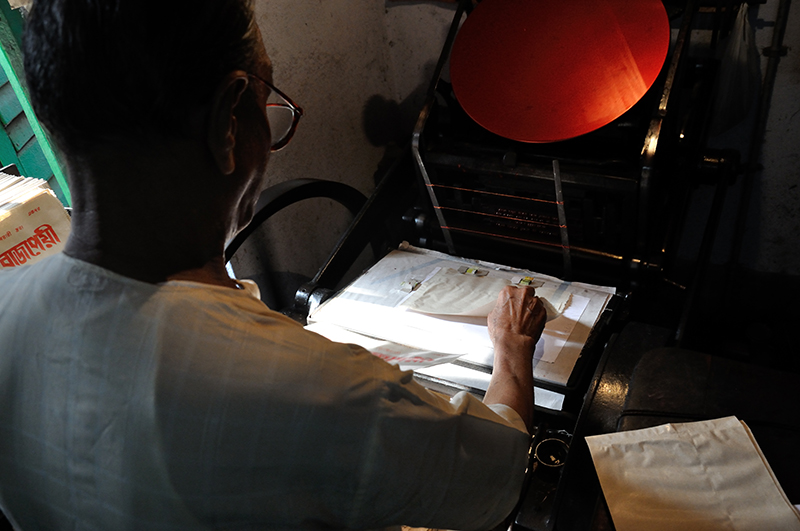Susnato Chowdhury




Grant Period: Over one year and six months
Susnato Chowdhury is an independent journalist and writer and the editor and publisher of the Bengali Little Magazine Bodhshabdo since 1999. He is a columnist and regular contributor to prestigious Bengali newspapers such as Anandabazar Patrika and Sangbad Pratidin. He has two published books titled Three A Shibtala Street (Offbeat, 2009) and Highway Highway (Ravana, 2015). He has worked as researcher and executive producer for non-fiction television programmes. He has a BA in Bengali from the University of Calcutta. Bodhshabdo has carved a niche among readers for carefully crafted aesthetics and well-curated content.
Little Magazines have a unique position in Bengali literature. They are known for their intellectually engaging content and alternative stands in opposition to mainstream magazines published by big media houses. The magazines published by big media appeal to the large mass of readers to maximize profit and therefore are often averse to experimental material requiring deeper engagement. Little Magazines on the other hand are often brought out by a group of likeminded people and have limited circulation. The principle aim of these magazines is to produce intellectually engaging content and spark debates and discourse on a range of subjects including literature, society and politics. Since they are not burdened by profit margins and have more or less a niche reader base they can take more risks in terms of experimentation with content and form. Many promising writers, poets and playwrights have come out of this circuit. The peak period of these magazines was through the 70’s and 80’s. Some Little Magazines have later gone on to become publishing houses themselves and many writers who started their journey in Little Magazines have later joined big media. The one thread that runs through the spirit of Little Magazines across time, aesthetics and geographical location is their staunch opposition to big media aesthetics.
Susnato has been working in this area for over a decade. His own magazine “Bodhshabdo” now acquires a place of respect among Little Magazines in Bengal. While many older magazines have either shut down in the era of digital media, unable to address the new reading habits and decreasing attention span of the readers or moved on to become big publishing houses, “Bodhshabdo” still carries the mantle of intellectually engaging content quite successfully. While content has been the king in Little Magazines, he observes, there has been exceptionally radical work in terms of form and aesthetics every once in a while. These works are not just products of creative whims of designers but there is a well thought out editorial policy that facilitates them. In case of Little Magazines the editor often is the person who designs the cover, decides the page structure and fonts etc. This gives him a unique opportunity to study the art of editing in Bengali Little Magazines over time. With his long experience in the field Susnato wants to study and transfer this knowledge to the younger generation through this project. In the era of digital designing and desktop publishing it has become absolutely possible for just one person to bring out a magazine for limited circulation. Susnato points out two problems with this shift – the expertise and exchange of ideas required for book designing and editing is decreasing, and the time dedicated to the whole process is greatly shortened - both resulting in standardised aesthetics. At a time when every book looks and feels the same, the art of editing needs to be addressed seriously. Little Magazines provide the perfect ground for such a practice as it is open to radical thinking but has only sporadically dedicated parts of that energy into designing.
Susnato wants to study the important instances of design and editing in Bengali Little Magazines in West Bengal and Bangladesh. He points out that there are often instances so radical that they almost made no sense to readers 20 years ago; but seem almost avant garde acts in retrospect today. He will travel extensively for this as many of these magazines were published from small towns of both sides of Bengal and adjacent states. He will also access old libraries and archives for this purpose. With the knowledge gathered from this research he will engage in a two-phase workshop. The workshop will bring together eminent practitioners from the field and young editors who have just started their own magazines. It will address the questions of different layouts in case of prose and poetry, inclusion and placement of advertisements, selection and use of fonts, significance of cover page design etc. The workshop will also provide basic understanding of various printing processes, analyse earlier works and create new works. The participants will regroup after sometime and will attempt to create new pages based on old magazines. They will work under the mentorship of experts for this. The outcome of these workshops will be a book addressing reconstruction of a few pages selected from various little magazines along with new pages created during the workshop. The whole process will also be presented in an exhibition at the end of the workshop.
IFA had supported two projects on Little Magazines in the past – one in Bengali and the other in Marathi. Those works were also presented in a panel discussion at the Apeejay Kolkata Literary Festival, 2014. If the Arts Practice programme considers curation as a practice, it is only legitimate that editing is also considered one. At this point in time when the book form and book making is going through radical shifts this project might prove to be useful for the community as it tries to address the future while taking lessons from the past. The final publication, audio-visual documentation of the workshop and the exhibition, research material and media reports will be deposited as deliverables to IFA.
